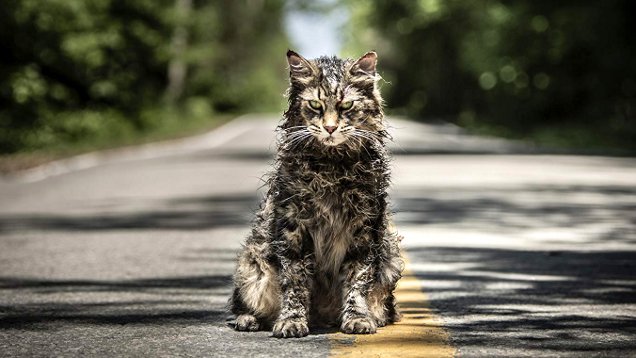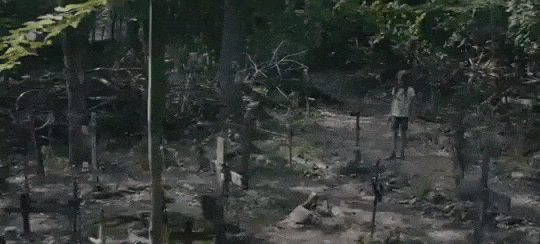Pet Sematary is a riveting and very gnarly horror movie about love, loss and a freaky puddy tat


The new and freakin’ gnarly adaptation of Stephen King’s classic novel about a graveyard that can bring things back from the dead is hellishly intense. The film also, as critic Luke Buckmaster explains, uses the story of a family who move to a small town to explore two of the greatest themes in the history of cinema.
The 1989 adaptation of Stephen King’s novel Pet Sematary begins memorably, the camera crawling through an animal graveyard while we hear sound grabs of kids eulogizing their deceased pets. “Bye old chap. See you in heaven,” says one grieving pipsqueak. “Spot, good fella, we love you,” contributes another. It’s an interesting scene because the creepiness and supernatural undertones, while unavoidable, come from a loving and poignant place: a yearning for something that’s been lost.
That scene didn’t make it into the new film from co-directors Kevin Kölsch and Dennis Widmyer, but the overarching sentiment – about a desire to rekindle lives no longer with us – certainly did. That element in fact is more pronounced this time around. The filmmakers trade in an emotional currency as gruesome as their gooey, gooseflesh-raising moments of disgusting spectacle. Much of the film’s humanity comes not from them but via a terrifically solemn performance from Jason Clarke, playing a father and husband for whom a cantankerous demomic cat proves the least of his problems.
In a key early scene Lois (Clarke) and his wife Rachel (Amy Seimetz) debate whether they should explain the concept of death to their young daughter Ellie (Jeté Laurence). Lois wants to treat Ellie as an intellectual equal, believing that discussing death is nothing to shy away from. Rachel argues otherwise, her perspective influenced by a traumatic incident from her youth involving the death of her sister, who was born with a bent spine and travelled to the Great Beyond in a rather ghastly way.
I like to think of this film, an exercise in jet black horror probably best appreciated by genre fans with cast iron stomachs, as a cautionary tale about not talking down to children. Mollycoddle young’uns with comforting fantasies all you like, the filmmakers appear to say, you can bet the house that grim reality will always punch through. This appeals to me as somebody who, for instance, despises the way the original Dumbo (not Tim Burton’s remake) opens, with that silly stork delivering babies to all the animals. This kind of infantalising flapdoodle is demeaning to children, telling them that the adult world is ours and the sandpit is theirs. Better to at least aspire to what the finest family films do: evoke the child in the adult and the adult in the child.

Desiring a slower pace than the hustle bustle of their city lives, and instead encountering horror beyond their wildest dreams (them’s the brakes in these types of movies), Lois, Rachel, Ellie and toddler Gage (Hugo and Lucas Lavoie) relocate to the backwoods of Maine. Actually there’s one more in the clan: the scene-stealing family cat Church, who spends a large portion of the running time hissing demonically. When Church dies their new neighbour Jud (John Lithgow) helps Lois bury the body in the titular location, which attracts creepy kids in animal masks performing semi-pagan rituals. He doesn’t mention that this mist-covered, surreal looking graveyard can bring things back from the dead. They didn’t put that bit on the real estate brochure.
A discussion about how “the ground is sour,” some kind of malevolent entity infusing the land beneath the characters’ feet, connects the film to another recent Stephen King adaptation – Zak Hilditch’s darkly meditative 1922, which tinkered with the idea of spiritual poison contaminating the natural world, putting terror in the terra firma. At one point Lois wakes up in bed with soil on his shoes, complicating what we had just rationalised as a dream sequence depicting him walking through the forest.
In this moment, which belongs to a hinterland between wakefulness and sleep, Lois steps through his bedroom doorway into a lush green outdoor setting, the framing of the door dividing two disparate realities. We observe a similar spatial effect, again smoothly executed, when Rachel sees a bathroom medicine cabinet transform into an area from her old house, key to the backstory about her sister. This sister is modelled in the spirit of Regan from The Exorcist: pure barf-splattered evil, the filmmakers opting for the creation of a hideous ghoul over anything/anybody who could have made the character vaguely human.
It’s that kind of film: nasty and exploitative and terribly unsubtle. Also very well made, with tightly controlled performances across the board, including from Clarke as well as head turning work from the young and talented Jeté Laurence. The evil hissing cat thing is done to death (in more than a single sense) and like most horror directors, Kölsch and Widmyer rely on a playbook of familiar techniques in the establishing and spilling over of tension. The language of the contemporary horror movie is so well formed that it is very difficult to break free of its grammar and syntax.
But with the bad – or at least the familiar – comes the good, or at least the surprising. While a critic naturally considers the crafting of specific sequences, it is the broader brush strokes in horror movies that offer the most liberty for storytellers. These kinds of films for example are not bound, by the audience’s expectations or anybody else’s, to abide by the strictures of the Hollywood happy ending, though nor are they necessarily expected to culminate in blanket doom and gloom. You can take or leave the individual scares in Pet Sematary; it’s the enveloping tone that’s much more thrilling. Thrilling also, and most importantly, is the clarity and breadth of its themes – especially ones concerning love and lost, two of the greatest themes in the history of the cinema.

















